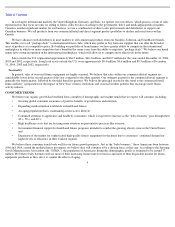Nautilus 2004 Annual Report Download - page 19
Download and view the complete annual report
Please find page 19 of the 2004 Nautilus annual report below. You can navigate through the pages in the report by either clicking on the pages listed below, or by using the keyword search tool below to find specific information within the annual report.
Table of Contents
Item 7. Management’s Discussion and Analysis of Financial Condition and Results of Operations
The purpose of the Management’s Discussion and Analysis of Financial Condition and Results of Operations (the “MD&A”) is to
provide readers with information necessary to understand the Company’s financial condition, changes in financial condition, liquidity and
capital resources, and results of operations, as well as our prospects for the future. Below is an index to the MD&A.
EXECUTIVE OVERVIEW
Executive Overview
18
Critical Accounting Policies
18
Results of Operations
21
Liquidity and Capital Resources
27
Off
-
Balance Sheet Arrangements
28
Inflation and Price Increases
28
Recent Accounting Pronouncements
28
Risks and Uncertainties
29
With the conclusion of 2004, we wrapped up an 18-month turnaround plan on schedule while continuing to increase our cash and short-
term investment position. For the year, we grew revenue by 5.0%, achieving net sales of nearly $524 million and earnings per diluted share of
$0.90 as the result of a robust direct business and strong sell through in our retail business. We believe we will generate double-digit revenue
and earnings growth for the next three years as we press forward to become the global leader in health and fitness.
The business results we are achieving are a direct outcome of our commitment to our “FIT #1” operating principals – financial rigor,
innovation, trust, and putting ourselves on a path to become the leader in every category where we compete.
We have made substantial progress positioning our Company for growth. We have four of the strongest brands in fitness today with
Nautilus and Bowflex leading the way followed by Schwinn Fitness and Stairmaster. We have momentum through new product innovation,
which accounted for approximately 30.0% of our revenue in 2004, compared to about 13.0% in 2003. We believe we are the only health and
fitness company positioned across all channels of distribution, providing us an opportunity to leverage innovations and brands with consumers
wherever they shop.
We believe 2004 was the year of the turnaround, not just to get our Company back on a growth track but to position our organization to
become the global leader in health and fitness over the long-term. This required a sequenced, multi-faceted business plan. It included new
leadership, new strategies, integrating past acquisitions, renewing our commitment to quality, entering new categories, forging customer
relationships and investing in innovation. All of these steps have positioned us for 2005, the first year of our new three-year growth plan. The
growth plan involves further increased investment in research and development, continuing the consolidation of our management information
systems, investing in brand marketing and finally defending our intellectual property.
CRITICAL ACCOUNTING POLICIES
This MD&A is based upon our Consolidated Financial Statements, which have been prepared in accordance with accounting principles
generally accepted in the United States of America. The preparation of these financial statements requires management to make estimates and
assumptions that affect the reported amounts of assets, liabilities, revenue and expenses, and related disclosure of contingent assets and
liabilities. Management bases its estimates on historical experience and on various other assumptions that are believed to be reasonable under
the circumstances, the results of which form the basis for making judgments about the carrying values of assets and liabilities that are not
readily apparent from other sources. Senior management has discussed the development, selection and disclosure of these estimates with the
Audit Committee of our Board of Directors. Actual results may differ from these estimates under different assumptions or conditions.
18
























